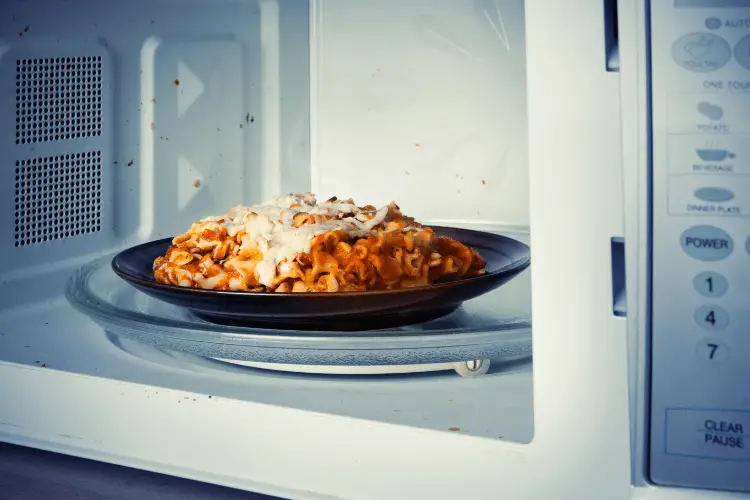A microwave is almost everyone’s favorite kitchen appliance. That’s why you’ll find it in almost every kitchen. It comes in handy when preparing meals, snacks, and beverages fast.
And just like microwaves, silicone is another popular material in the kitchen today. If it’s not a silicone cake mold, it’s a silicone bowl or plate.
There are also silicone pans and cups.
With all these utensils, you’ll want to use them in your microwave, but the biggest question is, can silicone go in the microwave? Yes, you can use silicone in the microwave as it is microwave safe.
How Safe is Silicone in the Microwave?
Silicone utensils are extremely safe in the microwave. You can use any silicone container in a microwave up to 428 degrees F.

Silicone cookware does not absorb microwave reflected rays. They get hot under high temperatures just like any other utensil. As such, you don’t have to worry about your pan or bowl getting too hot.
You can actually take out a frozen silicone pan and microwave it at any temperature. You can also put a silicone bowl directly to the freezer from the oven.
Silicone doesn’t leach into your food when heated, thus safe to use in a microwave. It also doesn’t emit fumes.
The material is also chemically inert, meaning that utensils made from this material are dishwasher-safe as chemicals and detergents can’t touch them.
Ways of Using Food-Grade Silicone

To use silicone dishes, you need to ensure that they are made of 100% food-grade silicone. If there are fillers in the utensils, it could compromise their durability.
Unlike plastic or glass, silicone can withstand extremely high temperatures, a feature that makes them the best for use in an oven or microwave.
It is actually more common to use silicone in the oven than in the microwave since it makes removing baked cakes easier.
So, if you’re into baking, get silicone baking tins and molds as they are flexible and with excellent non-stick properties.
Silicone vs. Plastic
If torn between plastic and silicone utensils, this comparison should help you settle for the best option:
| Silicone | Plastic |
|---|---|
| Fire resistant | Highly sensitive to fire |
| Durable | Not long-lasting |
| Low chemical reactivity level | Low chemical reactivity level |
| Low compression set | Shows deformation under load |
| No estrogen-mimicking chemicals | Contains estrogen-mimicking plastic |
| Oven safe | Not safe to use in the oven |
Silicone has many advantages that make it’s way better than plastic. It has incredibly outdated plastic even after being in this field only for a few years.
Disadvantages of Silicone
You can’t sing the praises of silicone without considering its problematic aspects. Some of its cons include:
- Poor tear strength
One of the significant drawbacks of silicone is its poor tear strength. And although the latest molds might improve, evaluation for the eligibility of this material needs to be done.
- Non-biodegradable
Because of its hybrid nature, silicone is not biodegradable. Failure to dispose of it properly means that it’ll sit in a landfill for years, meaning that it’s just as bad as plastic in this aspect.
- Wears away in extremely high temperatures
Although silicone doesn’t react to heat, exposing it to high temperatures can make it less stable and create compounds that’ll make it wear away.
- Rugged Outlook
Silicone utensils are durable, but after coming into contact with oil many times, they get a sticky touch, which gives them an oily, rougher, and dried-out look.
- Cost
Since silicone is a premium material, it has a higher price tag than plastic and plain rubber. However, the cons make it worth it.
Maximum Temperature for Silicone
The maximum temperature for silicone is 428 degrees Fahrenheit. Therefore, you can use it safely in the microwave, and it won’t melt.
Just ensure that it isn’t exposed to more than 428 degrees Fahrenheit or 260 degrees Celsius.
Frequently Asked Questions
Q: Can you use silicone cookware in a convection oven?
You can use silicone cookware/bakeware anywhere with no direct heat. You can use it in a convection oven, but ensure that the oven’s temperature doesn’t exceed 428 degrees Fahrenheit.
Q: Does silicone get toxic when burned?
Silicone is fire-resistant, thus challenging to ignite. It does not become toxic as well.
Q: Do silicone materials give off any foul odor?
No, silicone doesn’t give off foul odors that might affect the taste of your food.
Q: Can you put silicone in the microwave?
Yes, you can put silicone in the microwave since it’s heat resistant, doesn’t emit toxic gases when exposed to heat, or change the flavor of your food.
Q: Are silicone molds microwave safe?
Silicone molds are microwave-safe, oven-safe, and freezer-safe.
Q: Is silicone safe in the microwave?
Silicone doesn’t absorb microwaves, thus safe in the microwave oven. It also doesn’t leach harmful toxins in your food, unlike plastics.
Q: Are silicone baking cups microwave safe?
Silicone baking cups are microwave and oven-safe. You can also wash the cups in a dishwasher.
Q: Do silicone baking cups melt?
Silicone molds are heat-resistant and can be used at very high or low temperatures. You, however, need to be aware of the temperature ratings (shouldn’t go beyond 500 degrees Fahrenheit) to avoid melting the cups and ruining your work.
Q: Is silicone toxic when heated?
Silicone boasts a bonded composition, thus non-toxic, non-recyclable, and non-biodegradable.
Q: Is silicone flammable?
Silicone can’t be considered flammable. It can however catch fire and burn in high temperatures. The ignition temperature for silicone is 450 degrees Celsius.
Q: Does silicone melt in the oven?
Silicone flexes when hot but doesn’t melt until when exposed to 500 degrees Fahrenheit.
Conclusion
There you have it! The answer to the question – can silicone go in the microwave? Silicone makes high-quality cookware that you can use in a microwave oven without worries.
Unlike plastic, this material doesn’t melt and can’t cause arcing like metals do when placed in the microwave.
Silicone utensils last longer, are easy to clean and are extremely flexible. Although expensive, they are really worth going for.
